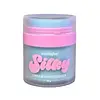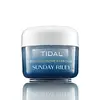What's inside
What's inside
 Key Ingredients
Key Ingredients

 Benefits
Benefits

 Concerns
Concerns

 Ingredients Side-by-side
Ingredients Side-by-side

Water
Skin ConditioningIsododecane
EmollientGlycerin
HumectantCetyl Alcohol
EmollientGlyceryl Stearate
EmollientPEG-100 Stearate
Polyacrylamide
Glycyrrhiza Glabra Root Extract
BleachingC13-14 Isoparaffin
EmollientPhenoxyethanol
PreservativeGlycolic Acid
BufferingAllantoin
Skin ConditioningBHT
AntioxidantChlorphenesin
AntimicrobialLaureth-7
EmulsifyingCaprylic/Capric Triglyceride
Masking1,2-Hexanediol
Skin ConditioningAloe Barbadensis Leaf Extract
EmollientCetyl-Pg Hydroxyethyl Palmitamide
Skin ConditioningCyclopentasiloxane
EmollientTitanium Dioxide
Cosmetic ColorantAlumina
AbrasivePEG-10 Dimethicone
Skin ConditioningLauryl Polyglyceryl-3 Polydimethylsiloxyethyl Dimethicone
Skin ConditioningHydrogen Dimethicone
Ceramide NP
Skin ConditioningCholesterol
EmollientSodium Hyaluronate
HumectantHydrogenated Lecithin
EmulsifyingButylene Glycol
HumectantHydroxypropyltrimonium Hyaluronate
Hydrolyzed Hyaluronic Acid
HumectantHyaluronic Acid
HumectantHydrolyzed Sodium Hyaluronate
Skin ConditioningSodium Hyaluronate Crosspolymer
HumectantPentylene Glycol
Skin ConditioningSodium Retinoyl Hyaluronate
Zinc Hydrolyzed Hyaluronate
HumectantSodium Acetylated Hyaluronate
HumectantPropanediol
SolventDimethylsilanol Hyaluronate
HumectantSodium Benzoate
MaskingAscorbylpropyl Hydrolyzed Hyaluronate
HumectantAscorbyl Propyl Hyaluronate
Skin ConditioningWater, Isododecane, Glycerin, Cetyl Alcohol, Glyceryl Stearate, PEG-100 Stearate, Polyacrylamide, Glycyrrhiza Glabra Root Extract, C13-14 Isoparaffin, Phenoxyethanol, Glycolic Acid, Allantoin, BHT, Chlorphenesin, Laureth-7, Caprylic/Capric Triglyceride, 1,2-Hexanediol, Aloe Barbadensis Leaf Extract, Cetyl-Pg Hydroxyethyl Palmitamide, Cyclopentasiloxane, Titanium Dioxide, Alumina, PEG-10 Dimethicone, Lauryl Polyglyceryl-3 Polydimethylsiloxyethyl Dimethicone, Hydrogen Dimethicone, Ceramide NP, Cholesterol, Sodium Hyaluronate, Hydrogenated Lecithin, Butylene Glycol, Hydroxypropyltrimonium Hyaluronate, Hydrolyzed Hyaluronic Acid, Hyaluronic Acid, Hydrolyzed Sodium Hyaluronate, Sodium Hyaluronate Crosspolymer, Pentylene Glycol, Sodium Retinoyl Hyaluronate, Zinc Hydrolyzed Hyaluronate, Sodium Acetylated Hyaluronate, Propanediol, Dimethylsilanol Hyaluronate, Sodium Benzoate, Ascorbylpropyl Hydrolyzed Hyaluronate, Ascorbyl Propyl Hyaluronate
Water
Skin ConditioningPropanediol
SolventGlycerin
HumectantCaprylic/Capric Triglyceride
MaskingEthyl Macadamiate
Skin ConditioningHydrolyzed Jojoba Esters
Skin ConditioningDicaprylyl Carbonate
EmollientIsododecane
EmollientSodium Acrylates Copolymer
Alpha-Arbutin
AntioxidantPhenoxyethanol
PreservativeCucumis Sativus Extract
Skin ConditioningPentylene Glycol
Skin ConditioningAdipic Acid/Neopentyl Glycol Crosspolymer
Lauryl Dimethicone
Skin ConditioningHydrogenated Polyisobutene
EmollientAllantoin
Skin ConditioningTetrasodium EDTA
Strelitzia Nicolai Seed Aril Extract
Skin ConditioningTamarindus Indica Seed Gum
Emulsion StabilisingAesculus Hippocastanum Seed Extract
Skin ConditioningSodium Hyaluronate Crosspolymer
HumectantSodium Hyaluronate
HumectantPapain
Skin ConditioningCarbomer
Emulsion Stabilising1,2-Hexanediol
Skin ConditioningAlgin
MaskingCaprylyl Glycol
EmollientLecithin
EmollientMelia Azadirachta Leaf Extract
Skin ConditioningMelia Azadirachta Flower Extract
Skin ConditioningCoccinia Indica Fruit Extract
Skin ConditioningSolanum Melongena Fruit Extract
Skin ConditioningAloe Barbadensis Flower Extract
EmollientOcimum Sanctum Leaf Extract
Skin ConditioningOcimum Basilicum Flower/Leaf Extract
TonicCurcuma Longa Root Extract
MaskingCorallina Officinalis Extract
Skin ConditioningEthylhexylglycerin
Skin ConditioningSodium Benzoate
MaskingPotassium Benzoate
PreservativeChlorphenesin
AntimicrobialTocopherol
AntioxidantMalic Acid
BufferingSynthetic Fluorphlogopite
Titanium Dioxide
Cosmetic ColorantTin Oxide
AbrasiveWater, Propanediol, Glycerin, Caprylic/Capric Triglyceride, Ethyl Macadamiate, Hydrolyzed Jojoba Esters, Dicaprylyl Carbonate, Isododecane, Sodium Acrylates Copolymer, Alpha-Arbutin, Phenoxyethanol, Cucumis Sativus Extract, Pentylene Glycol, Adipic Acid/Neopentyl Glycol Crosspolymer, Lauryl Dimethicone, Hydrogenated Polyisobutene, Allantoin, Tetrasodium EDTA, Strelitzia Nicolai Seed Aril Extract, Tamarindus Indica Seed Gum, Aesculus Hippocastanum Seed Extract, Sodium Hyaluronate Crosspolymer, Sodium Hyaluronate, Papain, Carbomer, 1,2-Hexanediol, Algin, Caprylyl Glycol, Lecithin, Melia Azadirachta Leaf Extract, Melia Azadirachta Flower Extract, Coccinia Indica Fruit Extract, Solanum Melongena Fruit Extract, Aloe Barbadensis Flower Extract, Ocimum Sanctum Leaf Extract, Ocimum Basilicum Flower/Leaf Extract, Curcuma Longa Root Extract, Corallina Officinalis Extract, Ethylhexylglycerin, Sodium Benzoate, Potassium Benzoate, Chlorphenesin, Tocopherol, Malic Acid, Synthetic Fluorphlogopite, Titanium Dioxide, Tin Oxide
Ingredients Explained
These ingredients are found in both products.
Ingredients higher up in an ingredient list are typically present in a larger amount.
1,2-Hexanediol is a synthetic liquid and another multi-functional powerhouse.
It is a:
- Humectant, drawing moisture into the skin
- Emollient, helping to soften skin
- Solvent, dispersing and stabilizing formulas
- Preservative booster, enhancing the antimicrobial activity of other preservatives
Allantoin is a soothing ingredient known for its protective and moisturizingg properties. Because of this, it is often added to products with strong active ingredients.
Studies show higher concentrations of this ingredient can promote wound healing.
Though it can be derived from the comfrey plant, allantoin is produced synthetically for cosmetic products to ensure purity.
Learn more about AllantoinThis ingredient is an emollient, solvent, and texture enhancer. It is considered a skin-softener by helping the skin prevent moisture loss.
It helps thicken a product's formula and makes it easier to spread by dissolving clumping compounds.
Caprylic Triglyceride is made by combining glycerin with coconut oil, forming a clear liquid.
While there is an assumption Caprylic Triglyceride can clog pores due to it being derived from coconut oil, there is no research supporting this.
Learn more about Caprylic/Capric TriglycerideChlorphenesin is a synthetic preservative. It helps protect a product against bacteria in order to extend shelf life. In most cases, Chlorphenesin is paired with other preservatives such as phenoxyethanol and caprylyl glycol.
Chlorphenesin is a biocide. This means it is able to help fight the microorganisms on our skin. It is also able to fight odor-releasing bacteria.
Chlorphenesin is soluble in both water and glycerin.
Studies show Chlorphenesin is easily absorbed by our skin. You should speak with a skincare professional if you have concerns about using Chlorphenesin.
Learn more about ChlorphenesinGlycerin is already naturally found in your skin. It helps moisturize and protect your skin.
A study from 2016 found glycerin to be more effective as a humectant than AHAs and hyaluronic acid.
As a humectant, it helps the skin stay hydrated by pulling moisture to your skin. The low molecular weight of glycerin allows it to pull moisture into the deeper layers of your skin.
Hydrated skin improves your skin barrier; Your skin barrier helps protect against irritants and bacteria.
Glycerin has also been found to have antimicrobial and antiviral properties. Due to these properties, glycerin is often used in wound and burn treatments.
In cosmetics, glycerin is usually derived from plants such as soybean or palm. However, it can also be sourced from animals, such as tallow or animal fat.
This ingredient is organic, colorless, odorless, and non-toxic.
Glycerin is the name for this ingredient in American English. British English uses Glycerol/Glycerine.
Learn more about GlycerinIsododecane is a fragrance, emollient, and solvent.
As an emollient, it helps your skin stay soft and hydrated. Emollients help trap moisture into your skin.
Isododecane's role as a solvent makes it a great texture enhancer. It spreads smoothly on skin and does not leave a sticky feeling behind. Isododecane also helps prevent color transfer in makeup products.
Isododecane is not absorbed into skin.
Learn more about IsododecanePentylene glycol is typically used within a product to thicken it. It also adds a smooth, soft, and moisturizing feel to the product. It is naturally found in plants such as sugar beets.
The hydrophilic trait of Pentylene Glycol makes it a humectant. As a humectant, Pentylene Glycol helps draw moisture from the air to your skin. This can help keep your skin hydrated.
This property also makes Pentylene Glycol a great texture enhancer. It can also help thicken or stabilize a product.
Pentylene Glycol also acts as a mild preservative and helps to keep a product microbe-free.
Some people may experience mild eye and skin irritation from Pentylene Glycol. We always recommend speaking with a professional about using this ingredient in your routine.
Pentylene Glycol has a low molecular weight and is part of the 1,2-glycol family.
Learn more about Pentylene GlycolPhenoxyethanol is a preservative that has germicide, antimicrobial, and aromatic properties. Studies show that phenoxyethanol can prevent microbial growth. By itself, it has a scent that is similar to that of a rose.
It's often used in formulations along with Caprylyl Glycol to preserve the shelf life of products.
Propanediol is an all-star ingredient. It softens, hydrates, and smooths the skin.
It’s often used to:
Propanediol is not likely to cause sensitivity and considered safe to use. It is derived from corn or petroleum with a clear color and no scent.
Learn more about PropanediolSodium Benzoate is a preservative. It's used in both cosmetic and food products to inhibit the growth of mold and bacteria. It is typically produced synthetically.
Both the US FDA and EU Health Committee have approved the use of sodium benzoate. In the US, levels of 0.1% (of the total product) are allowed.
Sodium benzoate works as a preservative by inhibiting the growth of bacteria inside of cells. It prevents the cell from fermenting a type of sugar using an enzyme called phosphofructokinase.
It is the salt of benzoic acid. Foods containing sodium benzoate include soda, salad dressings, condiments, fruit juices, wines, and snack foods.
Studies for using ascorbic acid and sodium benzoate in cosmetics are lacking, especially in skincare routines with multiple steps.
We always recommend speaking with a professional, such as a dermatologist, if you have any concerns.
Learn more about Sodium BenzoateSodium Hyaluronate is hyaluronic acid's salt form. It is commonly derived from the sodium salt of hyaluronic acid.
Like hyaluronic acid, it is great at holding water and acts as a humectant. This makes it a great skin hydrating ingredient.
Sodium Hyaluronate is naturally occurring in our bodies and is mostly found in eye fluid and joints.
These are some other common types of Hyaluronic Acid:
Learn more about Sodium HyaluronateSodium Hyaluronate Crosspolymer is a type of hyaluronic acid. In fact, it is modified version of hyaluronic acid.
The structure of Sodium Hyaluronate Crosspolymer allows it to stay in the skin's top layer for a longer period of time. This allows for even more hydration and humectant action than hyaluronic acid.
These are some other common types of Hyaluronic Acid:
Learn more about Sodium Hyaluronate CrosspolymerTitanium dioxide is a mineral UV filter widely used in sunscreens and cosmetics.
It is one of only two UV filters officially classified as “mineral” by regulatory agencies, the other being zinc oxide.
Titanium dioxide provides broad-spectrum protection mostly in the UVB and UVAII range, with some protection in the UVAI range.
While its UVA protection isn’t as strong as zinc oxide’s, the difference is minor.
A common myth is that mineral UV filters reflect UV light. However, modern research shows titanium dioxide absorbs UV radiation like chemical filters (~95% absorption & 5% reflection).
Thanks to its non-irritating nature, titanium dioxide is suitable for sensitive, acne-prone, or redness-prone skin. It is unlikely to cause "eye sting" like other sunscreen ingredients.
A major drawback of this ingredient is its white cast and thick texture. This is why mineral sunscreens often leave a white cast and are less cosmetically elegant than chemical/hybrid sunscreens.
To improve white cast and spreadability, micronized or nano-sized titanium dioxide is often used.
There are ongoing concerns surrounding nano-titanium oxide's impact on marine ecosystems.
There is no conclusive evidence that any form of titanium oxide (or any other sunscreen ingredients) will cause harm to marine ecosystems or coral reefs. The science is still developing but many consumers are keeping a close eye on this issue.
Please note, many destinations have reef-safety sunscreen rules. For instance, the U.S. Virgin Islands advises all visitors to use non-nano mineral sunscreens.
Nano mineral sunscreens once raised safety concerns about absorption into skin.
Extensive research has shown that they do not penetrate healthy or damaged skin; they remain safely on the surface and the top layer of dead skin (stratum corneum).
You'll likely find titanium dioxide bundled with alumina, silica, or dimethicone. These ingredients help make titanium dioxide highly photostable; this prevents it from interacting with other formula components under UV light.
Learn more about Titanium DioxideWater. It's the most common cosmetic ingredient of all. You'll usually see it at the top of ingredient lists, meaning that it makes up the largest part of the product.
So why is it so popular? Water most often acts as a solvent - this means that it helps dissolve other ingredients into the formulation.
You'll also recognize water as that liquid we all need to stay alive. If you see this, drink a glass of water. Stay hydrated!
Learn more about Water